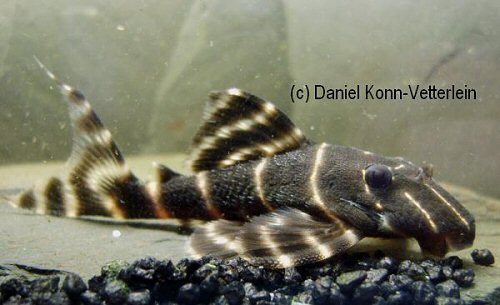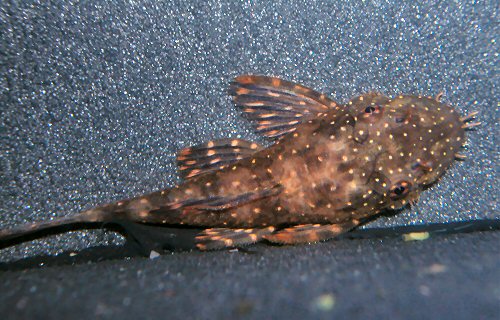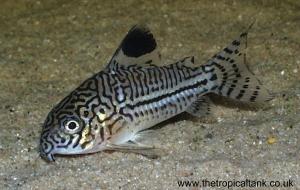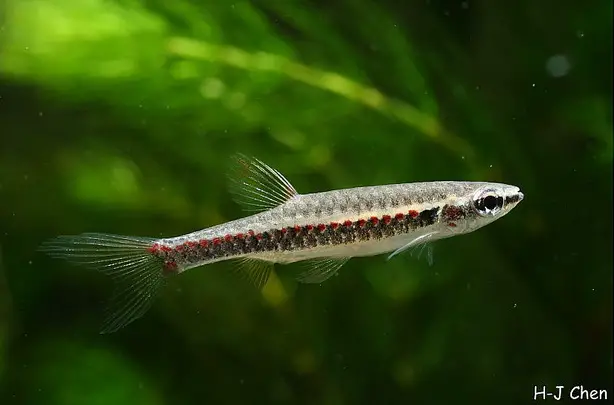Introduction
There is an emerging 'Amazonian biotope' concept that appears to be becoming widespread that combines some tangled wood, leaf litter and often a large group of mid-sized cichlids (often Apistogramma or Geophagus) in a way that doesn't look particularly natural in design and groups fish together that occupy the same broad geographic region (e.g. the 'Rio Negro') but I'm not sure actually live together. The Aquatic Gardners Association annual contest is full of this type of set-up.
The main motivation behind this article and tank concept is to explore what a true representation of this kind of habitat would look like and to serve as a way for me to better understand how widespread or restricted species distribution ranges actually are in the Amazon basin. I'm also becoming more interested in catfish (prompted in part by enjoying watching the Ancistrus I recently added to my Malawi hap tank to provide some algae control) and tetras, and so wanted to think about a potential home for some of these fish.
As an aside, Chris Lukhaup's superb photos of underwater scenes in Brazil (also see his wider photo collection here) show that aquatic plants do have a place in Amazonian biotopes, contrary to the current fashion, although it is equally clear that the 'nature aquarium' movement doesn't come close to replicating natural underwater environments.
The natural habitat
The Rio Ucayali in Peru is a major river in the Upper Amazon basin. The Ucayali and the neighbouring Marañón are the main source rivers of the Amazon, and the Amazon name is first used where these two rivers meet near the city of Iquitos.

There are plenty of pictures of the main channel of the Ucayali on-line (e.g. see Google Images). The main channel appears to have a diverse fauna of large catfish, characins and robust cichlids (e.g. see this short post about species of interest to anglers). However, the fish that we are most likely to be interested in for aquarium purposes are found away from the main channel, in small streams, lakes and the flooded forests.
There are a number of videos and photo journals from non-fishy visits to the Tapiche and Pacaya Samiria nature reserve (at the confluence of the Ucayali and Marañón) that give a sense of the wider environment around the Rio Ucayali.
The habitat I'm specifically interested in representing are the flooded forests along minor tributaries of the main river, as this is probably closest to the typical 'wood and leaves' amazonian 'biotope' efforts.
The best source I've found for pictures of this environment in the right region is this report on a collecting expedition to the Rio Tapiche, one of the tributaries of the Rio Ucayali. The pictures in this report and those below give a good sense of what I'm looking to replicate:
A few key thoughts on this environment:
1. There seem to be no, or very few, true aquatic plants in this habitat.
2. Floating plants are common, and there are often lots of them in a range of sizes. Whereas it seems unusual to find more than a couple of aquatic plant species growing in the same place in freshwater habitats, this doesn't seem to be the case for floating plants.
3. The substrate is consistently very fine white sand, almost silt or mud. It usually has some plant debris on it and can be covered by think layers of leaf litter, twigs and other bits.
4. The trees and roots don't need to be huge tree trunks to provide an accurate representation of the flooded forest, in fact smaller trees with a trunk up to 2-3 inches seem to be more common. The trees are also quite variable, you can see trees with buttressed roots, with aerial roots that look like multiple trunks and both smooth and heavily textured bark in the same areas.
5. There are
no rocks to be seen.
6. There is a place for emergent vegetation and for marginal plants growing into the water.
7. The water is moderately stained brown from tanins, although not so dark that you cannot see through it.
Inhabitants
One of the attractions of this aquarium concept is that many species from the area, and in particular those that have a slightly wider distribution in the Upper Amazon, are well known in the aquarium hobby as a result of the nearby city of Iquitos being a long-standing centre for fish exports. As a result, this biotope aquarium allows a fresh look at some common species in a more authentic setting and an opportunity to combine them with some less commonly seen species.
1. Catfish
Keeping the local catfish is a major motivation for this aquarium. In particular, there is a broad range of attractice loricariid (suckermouth catfishes or plecos) and callichthyid (Corydoras and relatives) catfish know from the area.
I'm a greater admirer of the twig and whiptail catfish of the subfamily Loricariinae. The spectacular Planiloricaria cryptodon (see Planet Catfish, also see the Jan-Feb 2015 issue of Amazonas magazine) was originally described from the Ucayali and seems to be restricted to the Peruvian Upper Amazon. For me, this fish is a must have. It is a large fish at 8-10 inches maximum size (according to Planet Catfish and Fishbase) and needs large, open sandy areas to be happy so it is a bit challenging to keep, but would be a great centerpiece for an Ucayali tank.
Amongst algae and plant eating plecos, Otocinclus cocama, the zebra oto, perhaps the most beautiful of the small loricariids (the subfamily Hypoptomatinae) comes from the Lower Ucayali and nearby. There is also an attractive undescribed Ancistrus, known as Ancistrus sp. Rio Ucayali, from the area.
There are also two stunning small wood eating plecos to choose from. Panaqolus albivermis is a real trophy catfish. It is not too big, at up to 6-8 inches, with a striking pattern of thin white lines over a dark background and a deeply forked tail with top and bottom fin extensions. It is appropriately also called the "Flash Pleco". Panaqolus albimaculatus is also an attractive species with white spots on a dark background.
The spectacular large wood eating pleco Panaque bathyphilus and large carnivorous pleco Pseudacanthicus L452 both reach at least a foot in length and are probably too large and robust for this aquarium.
Planet Catfish also reports a number of Chaetostoma and Astroblepus species from the areas. Whilst these are great fish, I think they are more closely adapted for fast flowing water and so are likely found higher upstream than the habitat we are looking at and so would be out of place with these other species.
In terms of Corydoras species, two attractive species that are commonly available, Corydoras panda and Corydoras trilineatus, are found in the Ucayali. Groups of both fish would make a great contrasting combination as panda has an attractive pinkish-tan base colour with a cute eye mask and spot on the caudal penduncle and trilineatus has a more greyish-silver base colour with a series of dots, squiggles and lines. Two rarer Corydoras species (amongst others) could be good 'upgrade' options for the cory fan, the undescribed CW018 is found near the Pacaya Samiria reserve (see this article about its discovery) and could replace trilineatus, with a denser pattern and beautiful shiny gold base colours, and C. virginiae or C138 a less common alternative to the panda. Brochis splendens also seems to be found in the area (..or at least something very similar is local, see here).
Finally, outside the pleco and corydoras families, the Jaguar Catfish Lisomodoras oncinus is known from the right area. It is a beautiful fish, but is an active predator and wouldn't go well with some of the smaller species I'd look to keep.
2. Tetras and other characins
Getting a complete list of appropriate characins is challenging.
Reports from collecting expeditions don't do a great job of identifying the characins they illustrate. What are clear from the photos is that Copella nattereri, one of the splashing tetras, and a marbled Carnegiella hatchetfish are present in the Ucayali basin.
Given that all of the marbled hatchets appear to currently be regarded as one species, C. strigata (see fishbase), we have to assume for now that this is the species shown. I have my doubts as C. strigata as currently understood has a vast range and pictures suggest it varies significantly across this range. In particular, the specimens pictured in the report linked to above from the Rio Tapiche have reddish caudal and anal fins that look quite distinctive.
Neon Tetras (Paracheirodon innesi), Three-Lined Pencilfish (Nannostomus trifasciatus) and Penguin Tetras (Thayeria boehlkei) are widespread in the Amazon basin and in the aquarium hobby and have ranges that are reported to extend into the Ucayali (e.g. http://www.seriouslyfish.com/species/paracheirodon-innesi/). All are good options.
For some more unusual choices, Hyphessobrycon frankei was originally described from the Ucayali and is beatiful fish (see profile in PFK interesting imports), and Hyphessobrycon loretoensis and H. peruvianus are both also present in at least the lower Ucayali (see Seriously Fish) and occasionally available in the UK aquarium hobby.
There are also at least 4 species of Hemibrycon (see here and here), but these are unlikely to have been imported as aquarium fish. These species Moenkhausia margitae and species of Creagrutus don't seem to be particularly attractive.
3. Cichlids
There is a very wide range of cichlids known from the Ucayali. The standard fishbase search page doesn't allow you to directly pull a list of species from the Ucayali, but googling "fishbase Ucayali" gives a good list, including:
Midwater cichlids: Acaronia nassa, Astronotus occelatus, Heros efasciatus, Mesonauta mirificus, Pterophyllum scalare
Acaras: Bujurquina apoparuana, Bujurquina syspilus, Cichlasoma amazonarum, Laetacara flabilabris, Laetacara thayeri
Pikes: Crenicichla anthurus, Crenicichla proteus
Eartheaters: Biotodoma cupido, Geophagus proximus
Dwarf cichlids: Crenicara punctulatum, Apistogrammoides pucallpaensis, many Apistogramma (see this article), including many that could be obtained without being a fully paid up member of hte Apisto fan club, A. cacatuoides, A. agassizii, A. cf. eunotus, A. njisseni (see Seriously Fish), A. huascar
Aquarium set-up and aquascaping
I would look to use a 5 foot by 2 foot aquarium for this set-up. The key constraint here is Planiloricaria, which requires large areas of bare sand substrate to be happy. I think anything smaller than 48 x 18 inches would certainly be too small and you'd have to restrict yourself to 1 specimen in this size tank.
The water should be soft and acidic (pH 6 or lower) and relatively warm (76 to 82 degrees F). Some of the sources referenced above suggest much more acidic and warmer water, but these are likely to be representative of the small forest streams rather than larger bodies of water.
Vertical wooden tree trunks and roots, either real or artificial, could form the main decor of the tank. This could be a combination of halved pieces along the sides, back and in the corners of the aquarium, including hollow artificual tree trunks that could be used to hide equipment, and complete pieces away from the sides. A commercial amazon-style 3D background could form part of this. This could be combined with robust pieces of bogwood and thinner twigs laid on the bottom between the vertical elements. Some real wood would be required as food if the Panaqolus or Panaque species are included.
The substrate would be fine white sand with some leaf litter, small twigs and other plant debris (e.g. savu pods, alder cones).
I would not use any submerged plants, but a mixture of floating plants. This could include Limnobium, Azolla caroliniana and Pistia stratioides. An example of all three growing together in the Amazon basin can be seen here: http://www.amazonian-fish.co.uk/images/floating_plants.jpg. Water hyacinth are also common and would be a good addition in a taller tank (otherwise the roots extend a long way down the water column, which looks odd) with an open top.
It would also be interesting to experiment with growing marginal plants in a paludarium / riparium set-up if an open-top aquarium was used.
I like the idea of using a frosted backdrop and soft backlighting to create the impression of depth, rather than a hard black backing to the tank. These pic show some of the effect I'd like to create.
I like the idea of using a frosted backdrop and soft backlighting to create the impression of depth, rather than a hard black backing to the tank. These pic show some of the effect I'd like to create.
Assuming a 5x2 foot aquarium, I would stock the following:
- 2-3x Planiloricaria cryptodon
- 1x Panaqolus albivermis
- 2x Ancistrus sp. Rio Ucayali
- 6x Corydoras panda
- 6x Corydoras trilineatus
- 2x Apistogramma cacatuioides
- 2x Apistogramma agassizii
- 10x Paracheirodon innesi
- 10x Hyphessobrycon loretoensis
- 8x Carnegiella strigata
- 4x Copella naterreri
These species are pictured below:

Beyond that, I've tried to make sure that every level of the aquarium will have some movement and interest. The Carnegiella and Copella should both fill the top levels of the tank. I'd be tempted to omit the Copella in favour of a larger group of the hatchetfish if I didn't go with the open top / marginal plant idea as some of the value of them would be to see them laying eggs out of the water. The Planiloricaria and Corydoras are all likely to enjoy the open sandy spaces of the aquarium, and the Panoqolus, Ancistrus and Apistogramma to spend most of their time in and around the wood and leaf-litter in the bottom half of the aquarium.
I've chosen the Apistogramma, rather than the other cichlids, as it will be important to give the Planiloricaria plenty of space in the open areas and to minimise more aggressive competition for food. Biotodoma or Laetacara could work as alternatives but I think the other cichlid species could prove too aggressive even in a large tank. I also like the idea of combining two common Apistogramma species in a bitopically correct set-up.
Overall the aquarium could look something like this:







/siluriformes/loricariidae/planiloricaria/cryptodon/13.jpg)











No comments:
Post a Comment